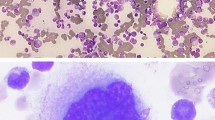Abstract
I.v. injection of Corynebacterium parvum (CP) into C57BL and BALB/c mice caused profound coagulation changes, featuring thrombocytopenia, decreased fibrinogen, increased fibrin/fibrinogen degradation products, and a concomitant microangiopathic haemolytic anaemia. These changes were greatest on the 9th day after CP, with recovery by Day 21. I.p. injection caused similar effects but s.c. injection was ineffective. Radiolabelled-platelet kinetics and distribution after i.v. CP indicated disseminated intravascular coagulation with rapid fibrinolysis, EACA treatment exacerbated the thrombosis. The coagulopathy correlated with hepatosplenomegaly, and both were dose dependent. Splenectomy did not effect the coagulopathy, but indomethacin totally abrogated the changes, suggesting that prostaglandin biosynthesis is involved in the pathogenesis.
Similar content being viewed by others
Rights and permissions
About this article
Cite this article
Mitcheson, H., Hilgard, P., McCraw, A. et al. Mechanisms of C. parvum-induced coagulopathy in mice. Br J Cancer 41, 117–122 (1980). https://doi.org/10.1038/bjc.1980.13
Issue Date:
DOI: https://doi.org/10.1038/bjc.1980.13
- Springer Nature Limited




